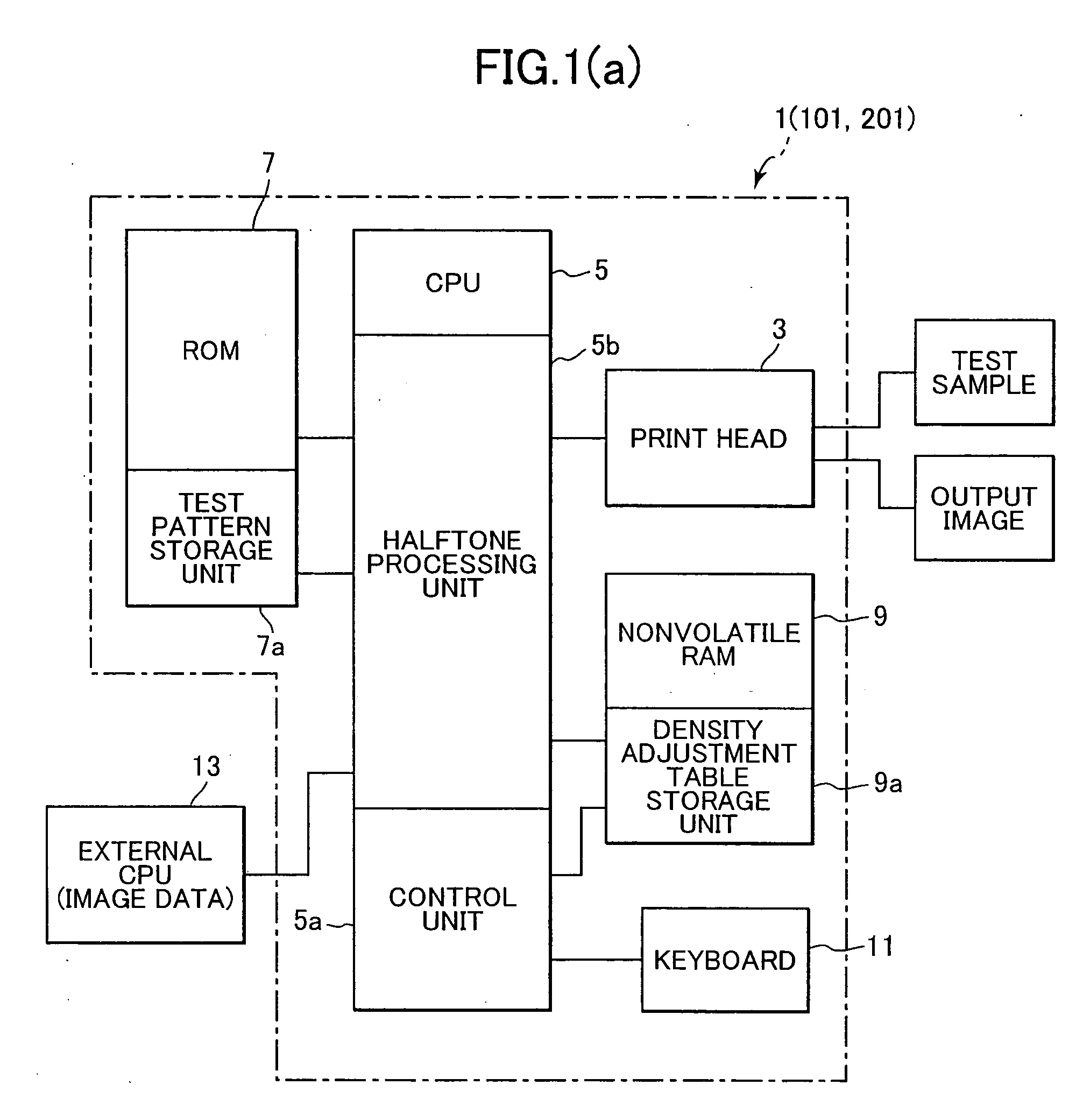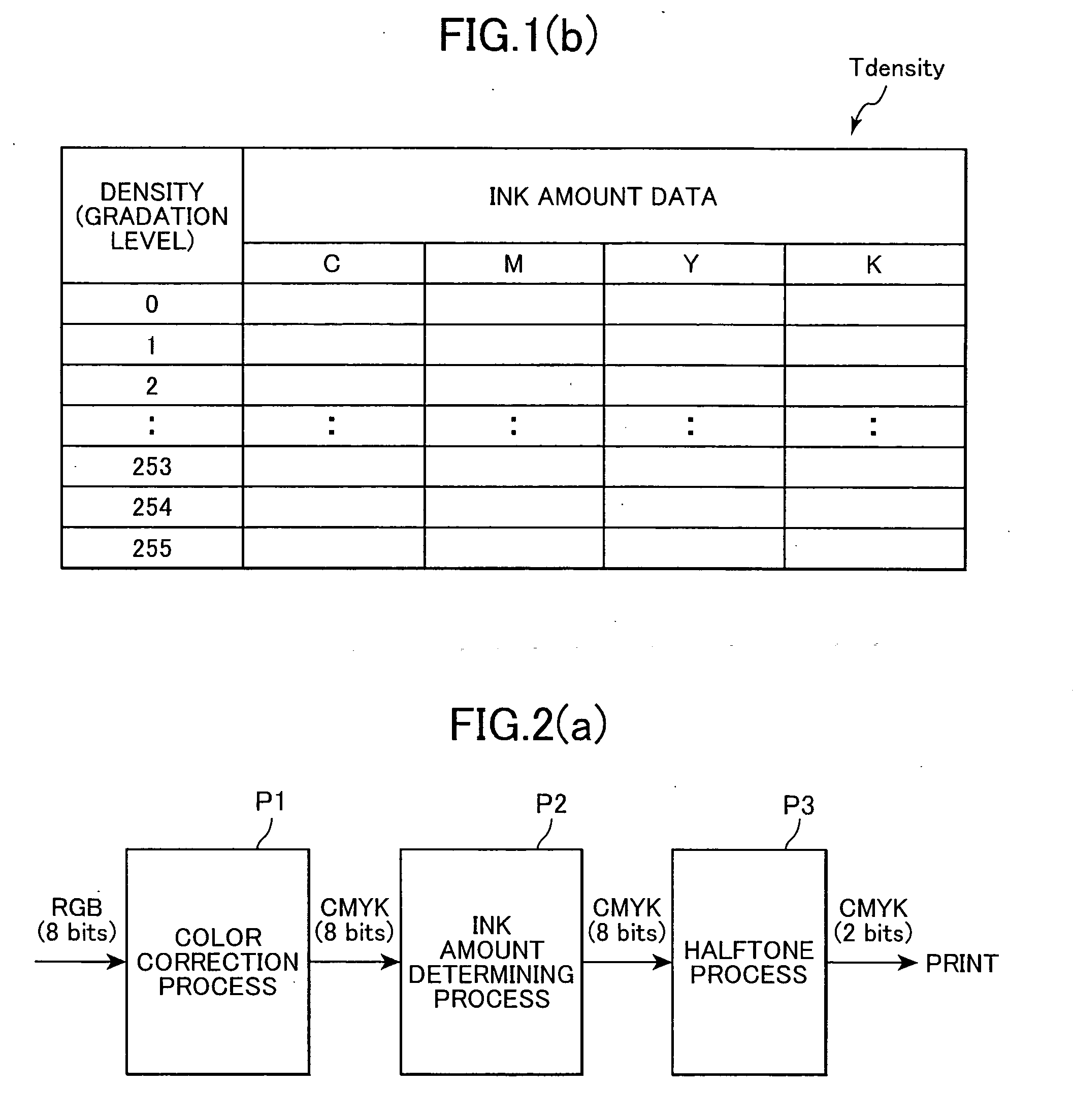Image-forming device
a technology of forming device and image, which is applied in the field of image forming device, can solve the problems of reducing the quality of gray image, affecting the quality of image, and affecting the quality of imag
- Summary
- Abstract
- Description
- Claims
- Application Information
AI Technical Summary
Benefits of technology
Problems solved by technology
Method used
Image
Examples
first embodiment
[0050] First, an inkjet printer 1 according to a first embodiment of the present invention will be described with reference to FIG. 1(a) to FIG. 5(b).
[0051] First, the structure of the inkjet printer 1 will be described with reference to FIG. 1.
[0052] The printer 1 includes: a print head 3; a central processing unit (CPU) 5; a ROM 7; a nonvolatile RAM 9; and a keyboard 11. The central processing unit (CPU) 5 is connected to an external CPU 13, which is provided in a personal computer or the like, and is capable of receiving data from the external CPU 13.
[0053] Although not shown in the drawings, the print head 3 includes nozzles that eject a cyan (C) ink, nozzles that eject a magenta (M) ink, nozzles that eject a yellow (Y) ink, and nozzles that eject a black (K) ink. The print head 3 forms color images by superimposing images in these four colors of ink. It is noted that the print head 3 forms gray images by superimposing ink in the four colors of cyan, magenta, yellow, and blac...
second embodiment
[0138] Next, a printer 101 according to a second embodiment of the present invention will be described with reference to FIG. 1 and FIGS. 6-14.
[0139] While the structure and operations of the printer 101 according to the second embodiment are essentially identical to those of the printer 1 in the first embodiment except that the printer 101 executes the density adjustment table creating process of FIGS. 6-14 instead of executing the density adjustment table creating process of FIGS. 3-5(a).
[0140] The density adjustment table creating process according to the second embodiment will be described below with reference to FIGS. 6-14.
[0141] As shown in FIG. 6, the density adjustment table creating process of the second embodiment is the same as that of the first embodiment of FIG. 3 except that processes of S430-S450 are executed instead of the process of S130 (FIG. 3) and processes of S470 and S480 are executed instead of the process of S150 (FIG. 3).
[0142] In S430, in the same manne...
third embodiment
[0190] Next, a printer 201 according to a third embodiment of the present invention will be described with reference to FIG. 1 and FIGS. 15(a)-15(c).
[0191] The structure and operation of the printer 201 according to the third embodiment is essentially identical to those of the printer 1 according to the first embodiment except that another density adjustment table Tdensity′ shown in FIG. 15(a) is stored in the density adjustment table storage unit 9a instead of the density adjustment table Tdensity of FIG. 1(b), that the density adjustment table creating process of FIG. 3 is modified so that the correcting processes of S130-S150 is omitted from the density adjustment table creating process, and that an image-forming process of FIGS. 15(b) and 15(c) is executed instead of the image-forming process of FIG. 2(b).
[0192] According to the present embodiment, the correcting processes of S130-S150 are not executed during the density adjustment table creating process of FIG. 3. By executin...
PUM
 Login to View More
Login to View More Abstract
Description
Claims
Application Information
 Login to View More
Login to View More - R&D
- Intellectual Property
- Life Sciences
- Materials
- Tech Scout
- Unparalleled Data Quality
- Higher Quality Content
- 60% Fewer Hallucinations
Browse by: Latest US Patents, China's latest patents, Technical Efficacy Thesaurus, Application Domain, Technology Topic, Popular Technical Reports.
© 2025 PatSnap. All rights reserved.Legal|Privacy policy|Modern Slavery Act Transparency Statement|Sitemap|About US| Contact US: help@patsnap.com



